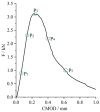Fracture Behavior of Steel-Fiber-Reinforced High-Strength Self-Compacting Concrete: A Digital Image Correlation Analysis
- PMID: 40805509
- PMCID: PMC12348553
- DOI: 10.3390/ma18153631
Fracture Behavior of Steel-Fiber-Reinforced High-Strength Self-Compacting Concrete: A Digital Image Correlation Analysis
Abstract
In this study, steel fibers were used to improve the mechanical properties of high-strength self-compacting concrete (HSSCC), and its effect on the fracture mechanical properties was investigated by a three-point bending test with notched beams. Coupled with the digital image correlation (DIC) technique, the fracture process of steel-fiber-reinforced HSSCC was analyzed to elucidate the reinforcing and fracture-resisting mechanisms of steel fibers. The results indicate that the compressive strength and flexural strength of HSSCC cured for 28 days exhibited an initial decrease and then an enhancement as the volume fraction (Vf) of steel fibers increased, whereas the flexural-to-compressive ratio linearly increased. All of them reached their maximum of 110.5 MPa, 11.8 MPa, and 1/9 at 1.2 vol% steel fibers, respectively. Steel fibers significantly improved the peak load (FP), peak opening displacement (CMODP), fracture toughness (KIC), and fracture energy (GF) of HSSCC. Compared with HSSCC without steel fibers (HSSCC-0), the FP, KIC, CMODP, and GF of HSSCC with 1.2 vol% (HSSCC-1.2) increased by 23.5%, 45.4%, 11.1 times, and 20.1 times, respectively. The horizontal displacement and horizontal strain of steel-fiber-reinforced HSSCC both increased significantly with an increasing Vf. HSSCC-0 experienced unstable fracture without the occurrence of a fracture process zone during the whole fracture damage, whereas the fracture process zone formed at the notched beam tip of HSSCC-1.2 at its initial loading stage and further extended upward in the beams of high-strength self-compacting concrete with a 0.6% volume fraction of steel fibers and HSSCC-1.2 as the load approaches and reaches the peak.
Keywords: digital image correlation technology; fracture mechanical properties; fracture toughness; high-strength self-compacting concrete.
Conflict of interest statement
Authors Maoliang Zhang, Huiling Yin and Yan Ma were employed by the company Henan Building Materials Research and Design Institute Co., Ltd. The remaining authors declare that the research was conducted in the absence of any commercial or financial relationships that could be construed as a potential conflict of interest.
Figures










References
-
- Jalal M., Mansouri E. Mechanical, rheological, durability and microstructural properties of high performance self-compacting concrete containing SiO2 micro and nanoparticles. Mater. Des. 2012;34:389–400. doi: 10.1016/j.matdes.2011.08.037. - DOI
-
- Ramkumar K.B., Rajkumar K.P.R. A Review on Performance of Self-Compacting Concrete-Use of Mineral Admixtures and Steel Fibers with Artificial Neural Network Application. Constr. Build. Mater. 2020;261:120215. doi: 10.1016/j.conbuildmat.2020.120215. - DOI
-
- Tantray M.A. Characteristic influence of carbon fibers on fresh state, mechanical properties and microstructure of carbon fiber based self-compacting concrete. Mater. Today Proc. 2021;38:3181–3189.
-
- Elik Z., Bingl A.F. Fracture properties and impact resistance of self-compacting fiber reinforced concrete. Mater. Struct. 2020;53:50. doi: 10.1617/s11527-020-01487-8. - DOI
-
- Abdalla M.S., Afzal H.K. Strength and flexural behavior of steel fiber and silica fume incorporated self-compacting concrete. J. Mater. Res. Technol. 2021;12:1380–1390. doi: 10.1016/j.jmrt.2021.03.066. - DOI
Grants and funding
LinkOut - more resources
Full Text Sources

